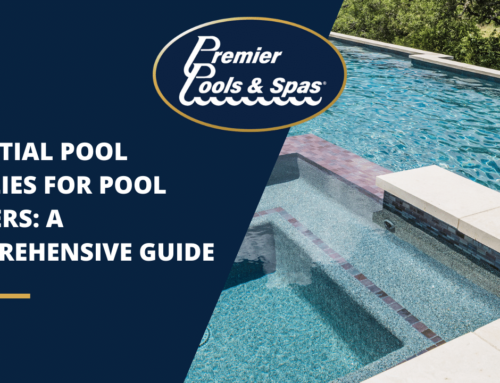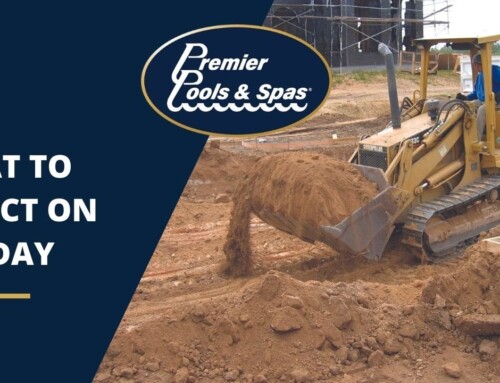
Ever since you were a kid you wanted your own swimming pool. You begged your parents for one every year. They said, “no” every year too.
Your parents claimed no one in the house could take care of the dog, so how would anyone help take care of a swimming pool?
They had a point. If you’ve never had a pool before you do have to learn how to maintain it. There’s also a big difference between taking care of a dog and maintaining a swimming pool.
We should know. With over 20 years of experience, we’ve built a lot of pools. Not one pool owner has ever compared dogs and pools.
While we don’t claim to be experts in pet care, we know pools. We also know most pool owners have no problem caring for their pool as long as they read the directions.
Before diving into pool ownership, read our guide to swimming pool maintenance.
Time to Open the Pool
Unless you enjoyed winter swimming, you’ll go through the process of opening your pool for the swim season.
If you kept a cover on the pool over the winter drain as much water as you can before removing it. Consider purchasing a cover pump and save yourself some work. Blow or sweep leaves and debris off of the cover before you remove it.
Once you’ve removed, cleaned, and dried the pool cover, fold it and store in a dry place. Your next set of pool opening tasks include:
- Raising the water level
- Reconnecting pool equipment
- Removing winter plugs
- Re-attaching drain plugs
Once you’ve finished this to-do list, you can begin turning the pool equipment on.
If you don’t swim all winter, you’ll do this process in reverse before cold weather arrives in your area. It’s called closing the pool and we’ll talk about it later.
The rest of the steps we’ll discuss are routine tasks all pool owners perform throughout the swimming season.
Keep the Pool Full
When you open the pool, you raise the water level. During swimming season, you may notice water disappearing from the pool. Don’t worry, no one is stealing water from you during the night.
All pools lose water because of evaporation.
The rate of evaporation depends on the following:
- Relative humidity
- Daily temperature
- Wind conditions
- Swimming activity
- Use of a pool heater
- Pool cover
If you don’t use a pool cover, expect to lose about 2 inches of your water level per week. The water loss is from evaporation. Pools also lose water because of frequent backwashing.
The ideal water level is the halfway point on the skimmer hatch. If it drops below the one-third level, add water. If water goes above the half-way level, drain until you get it within the ideal range.
Water level affects not only your swimming enjoyment, but it also affects the way the pool skimmer works.
Clean the Skimmers
Before we continue, let’s cut any confusion about skimmers. You’ll buy a tool that helps skim debris from the pool. That’s not a skimmer, it’s a net.
If you’re not sure what a pool skimmer looks like, find the top part of the pool wall. You’ll see a rectangular shaped opening. That’s the skimmer.
A pool skimmer uses suction to draw debris in and trap it in the skimmer basket.
The skimmer depends on correct water level to do its job efficiently. If the water level is too high, debris passes by the opening. If water level covers the skimmer opening completely, the skimmer door won’t open at all.
When the water level is too low, you run the risk of the skimmer bottoming out. Then it sucks air into the system. If you get air in your filtration system, you could ruin the filter pump motor.
Your job is cleaning out the skimmer basket(s) every day. If you let debris accumulate, you can overwork the pool pump.
Run the Pumps and Filters
The primary job of your pool pump is cleaning the pool water. The pump pulls dirty water in, sends it to the filter where it’s cleaned, and then pushes it back out to the pool.
When thinking about the pump and filter, you have two jobs:
- Determining how long you should run the pump.
- Knowing when to backwash the filter.
In the perfect swimming world, you’d never shut the pump down. Your only concern would be diving into crystal-clear blue water.
Leaving a pool pump running 24/7 results in high energy bills and the risk of wearing out your pool equipment prematurely. Most pool pump manufacturers suggest running your pump 10-12 hours each day.
Another part of your pool maintenance includes cleaning the pool filter. Pool filters come in one of three types:
- Cartridge
- Sand
- Diatomaceous earth (D.E.)
Filter type determines the cleaning method. sand. Your pool maintenance expert can tell you what filter type you have and provide cleaning instructions.
Swimming Pool Chemistry Class
You thought high school chemistry class was in the past, didn’t you? Owning a swimming pool does include managing the chemical balance in the water. Don’t panic—you don’t need to remember the periodic table.
Buy a water testing kit and set up a testing schedule. Testing frequency depends on how often you swim and what you’re testing.
Here’s a sample test schedule:
- Chlorine – 2 to 3 times per week
- pH – check when you test the chlorine level
- Alkalinity – once a month
- Calcium – monthly
No periodic table memorization needed. Pool water testing ensures you swim in a sanitary environment. Testing also helps extend the life of your pool equipment and the pool surface.
Polish Your Scrubbing Skills
We mentioned the net skimmer earlier. Skimming, brushing and vacuuming all come under your jurisdiction now that you own a pool.
You can buy a nifty pool brush and put the kids to work. Anyone can use a net skimmer and if you have older kids, you can show them how the pool vacuum works.
It doesn’t matter who does it, just do it! Brush and vacuum at least one each week. You’ll know when to bring out the net skimmer—anytime you see leaves and other debris floating.
By the way, the kids will get a kick out of skimming up all the dead bugs that accumulate overnight.
Create a Pool Maintenance Schedule
You’re going to love having your own swimming pool. Even so, you lead a busy life and should come up with a reasonable maintenance schedule.
Treat pool maintenance like other household tasks. A whiteboard works great and lets you take turns assigning jobs to different family members each week. If you don’t like whiteboards, print and laminate the schedule and post it.
You can also create a pool manual and include your schedule and any specific instructions.
This may sound like common sense but think about how often people in your household forget to empty the dishwasher or feed the dog. Looks like your parents were right about one thing.
Time to Close the Pool
Remember when we discussed opening the pool, we let you know you’d reverse the process at the end of swimming season? There’s one more pool closing task you may have depending on where you live.
If temperatures drop below freezing in your area, consider winterizing your pool.
Winterizing includes draining water from the filter and heater (if you have one). You’ll also ensure you don’t leave water in the pool plumbing and then disconnect the pump and heater.
Assign everybody one more round of skimming, brushing, and vacuuming.
Once you finish cleaning, you’re ready to lower the water level. You spent all season making sure you didn’t let the water level fall halfway below the skimmer.
It’s different when you winterize because you lower the water level to about 18 inched below the pool coping.
Your final winterization task is covering the pool. It’s a great time to dust off the cover and make sure no mold or mildew developed on it in storage.
If your climate allows it and you don’t mind year-round pool duty, why not keep it open all winter? Check with your pool builder and see what advice they give you.
More Swimming Pool Questions?
Earlier we said anyone who can read can keep up with a swimming pool. Well, you’ve read about most of the basics and should feel ready for opening day. All you need now is a new pair of swim fins, right?
We do realize even the most confident pool owners have questions about pool maintenance now and then. We love to answer them!
If you have other questions we didn’t address in this post or you’d like to talk about installing a swimming pool, contact us.



